Comprehensive Analysis of FBT and Capital Gains Tax in Taxation Law
VerifiedAdded on 2023/03/21
|8
|2528
|34
Homework Assignment
AI Summary
This document presents a detailed solution to a taxation law assignment focusing on Fringe Benefits Tax (FBT) and Capital Gains Tax (CGT). The assignment begins with an analysis of FBT, comparing the statutory formula method and the operating cost method for calculating car fringe benefits, including relevant expenses and employee contributions. It then proceeds to analyze various scenarios related to Capital Gains Tax, determining tax implications for different asset types, including residential properties, artworks, yachts, and shares. The solution provides calculations for capital gains and losses, incorporating previous year losses and applying relevant tax rules. The document includes references to relevant legislation and provides a comprehensive breakdown of the tax implications for each scenario, offering insights into minimizing tax liabilities and understanding the application of tax laws.
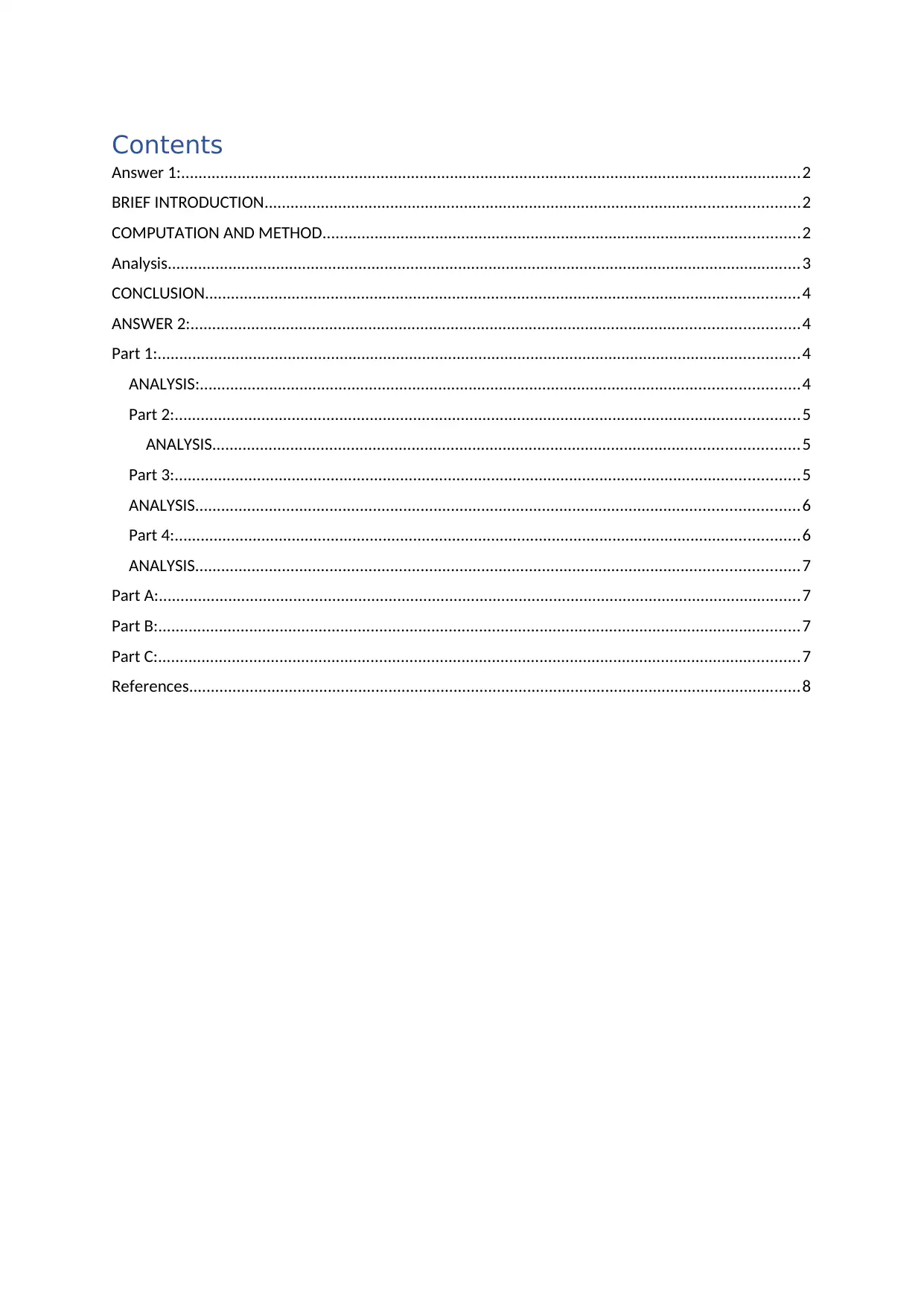
Contents
Answer 1:...............................................................................................................................................2
BRIEF INTRODUCTION...........................................................................................................................2
COMPUTATION AND METHOD..............................................................................................................2
Analysis..................................................................................................................................................3
CONCLUSION.........................................................................................................................................4
ANSWER 2:............................................................................................................................................4
Part 1:....................................................................................................................................................4
ANALYSIS:..........................................................................................................................................4
Part 2:................................................................................................................................................5
ANALYSIS.......................................................................................................................................5
Part 3:................................................................................................................................................5
ANALYSIS...........................................................................................................................................6
Part 4:................................................................................................................................................6
ANALYSIS...........................................................................................................................................7
Part A:....................................................................................................................................................7
Part B:....................................................................................................................................................7
Part C:....................................................................................................................................................7
References.............................................................................................................................................8
Answer 1:...............................................................................................................................................2
BRIEF INTRODUCTION...........................................................................................................................2
COMPUTATION AND METHOD..............................................................................................................2
Analysis..................................................................................................................................................3
CONCLUSION.........................................................................................................................................4
ANSWER 2:............................................................................................................................................4
Part 1:....................................................................................................................................................4
ANALYSIS:..........................................................................................................................................4
Part 2:................................................................................................................................................5
ANALYSIS.......................................................................................................................................5
Part 3:................................................................................................................................................5
ANALYSIS...........................................................................................................................................6
Part 4:................................................................................................................................................6
ANALYSIS...........................................................................................................................................7
Part A:....................................................................................................................................................7
Part B:....................................................................................................................................................7
Part C:....................................................................................................................................................7
References.............................................................................................................................................8
Paraphrase This Document
Need a fresh take? Get an instant paraphrase of this document with our AI Paraphraser
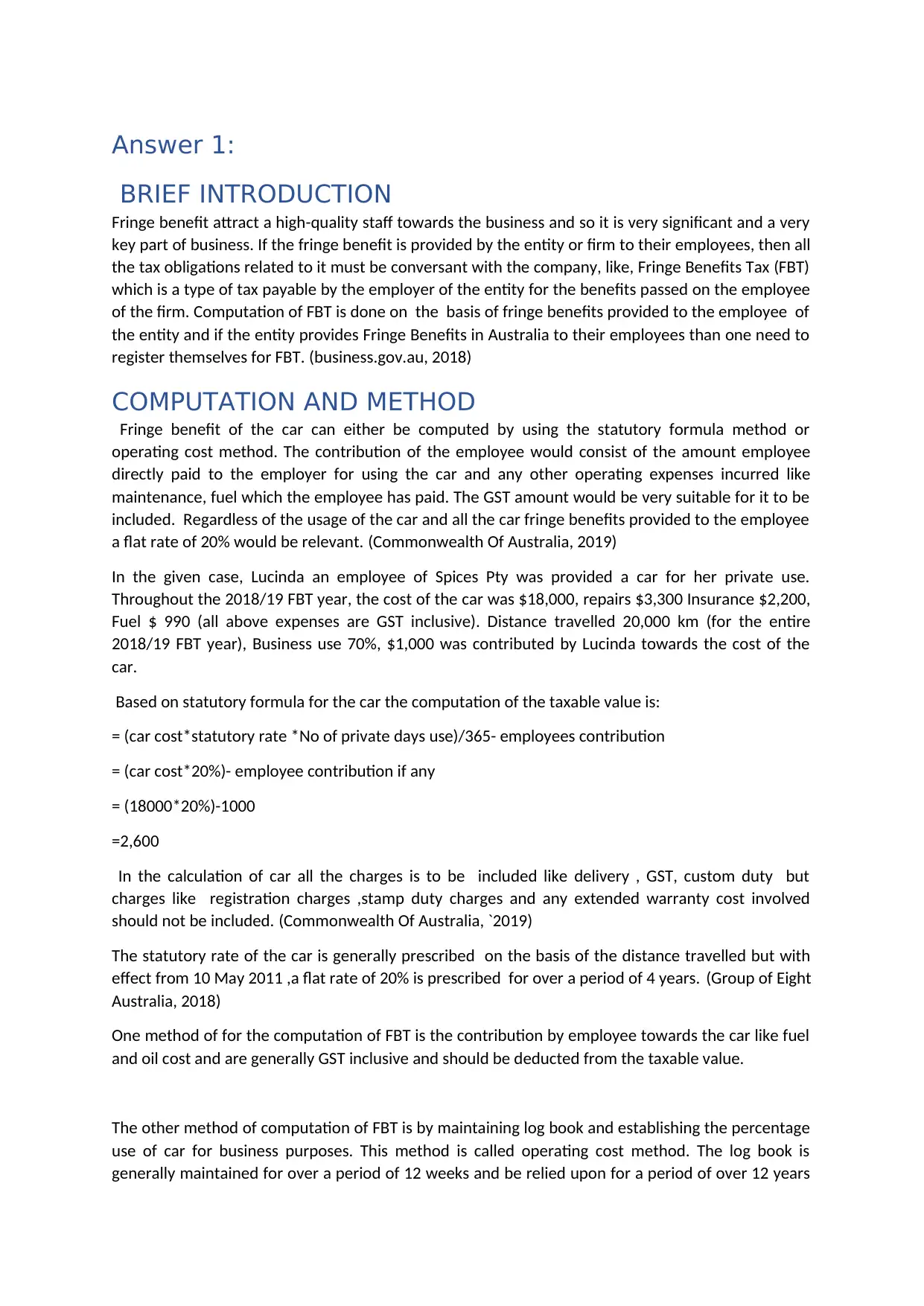
Answer 1:
BRIEF INTRODUCTION
Fringe benefit attract a high-quality staff towards the business and so it is very significant and a very
key part of business. If the fringe benefit is provided by the entity or firm to their employees, then all
the tax obligations related to it must be conversant with the company, like, Fringe Benefits Tax (FBT)
which is a type of tax payable by the employer of the entity for the benefits passed on the employee
of the firm. Computation of FBT is done on the basis of fringe benefits provided to the employee of
the entity and if the entity provides Fringe Benefits in Australia to their employees than one need to
register themselves for FBT. (business.gov.au, 2018)
COMPUTATION AND METHOD
Fringe benefit of the car can either be computed by using the statutory formula method or
operating cost method. The contribution of the employee would consist of the amount employee
directly paid to the employer for using the car and any other operating expenses incurred like
maintenance, fuel which the employee has paid. The GST amount would be very suitable for it to be
included. Regardless of the usage of the car and all the car fringe benefits provided to the employee
a flat rate of 20% would be relevant. (Commonwealth Of Australia, 2019)
In the given case, Lucinda an employee of Spices Pty was provided a car for her private use.
Throughout the 2018/19 FBT year, the cost of the car was $18,000, repairs $3,300 Insurance $2,200,
Fuel $ 990 (all above expenses are GST inclusive). Distance travelled 20,000 km (for the entire
2018/19 FBT year), Business use 70%, $1,000 was contributed by Lucinda towards the cost of the
car.
Based on statutory formula for the car the computation of the taxable value is:
= (car cost*statutory rate *No of private days use)/365- employees contribution
= (car cost*20%)- employee contribution if any
= (18000*20%)-1000
=2,600
In the calculation of car all the charges is to be included like delivery , GST, custom duty but
charges like registration charges ,stamp duty charges and any extended warranty cost involved
should not be included. (Commonwealth Of Australia, `2019)
The statutory rate of the car is generally prescribed on the basis of the distance travelled but with
effect from 10 May 2011 ,a flat rate of 20% is prescribed for over a period of 4 years. (Group of Eight
Australia, 2018)
One method of for the computation of FBT is the contribution by employee towards the car like fuel
and oil cost and are generally GST inclusive and should be deducted from the taxable value.
The other method of computation of FBT is by maintaining log book and establishing the percentage
use of car for business purposes. This method is called operating cost method. The log book is
generally maintained for over a period of 12 weeks and be relied upon for a period of over 12 years
BRIEF INTRODUCTION
Fringe benefit attract a high-quality staff towards the business and so it is very significant and a very
key part of business. If the fringe benefit is provided by the entity or firm to their employees, then all
the tax obligations related to it must be conversant with the company, like, Fringe Benefits Tax (FBT)
which is a type of tax payable by the employer of the entity for the benefits passed on the employee
of the firm. Computation of FBT is done on the basis of fringe benefits provided to the employee of
the entity and if the entity provides Fringe Benefits in Australia to their employees than one need to
register themselves for FBT. (business.gov.au, 2018)
COMPUTATION AND METHOD
Fringe benefit of the car can either be computed by using the statutory formula method or
operating cost method. The contribution of the employee would consist of the amount employee
directly paid to the employer for using the car and any other operating expenses incurred like
maintenance, fuel which the employee has paid. The GST amount would be very suitable for it to be
included. Regardless of the usage of the car and all the car fringe benefits provided to the employee
a flat rate of 20% would be relevant. (Commonwealth Of Australia, 2019)
In the given case, Lucinda an employee of Spices Pty was provided a car for her private use.
Throughout the 2018/19 FBT year, the cost of the car was $18,000, repairs $3,300 Insurance $2,200,
Fuel $ 990 (all above expenses are GST inclusive). Distance travelled 20,000 km (for the entire
2018/19 FBT year), Business use 70%, $1,000 was contributed by Lucinda towards the cost of the
car.
Based on statutory formula for the car the computation of the taxable value is:
= (car cost*statutory rate *No of private days use)/365- employees contribution
= (car cost*20%)- employee contribution if any
= (18000*20%)-1000
=2,600
In the calculation of car all the charges is to be included like delivery , GST, custom duty but
charges like registration charges ,stamp duty charges and any extended warranty cost involved
should not be included. (Commonwealth Of Australia, `2019)
The statutory rate of the car is generally prescribed on the basis of the distance travelled but with
effect from 10 May 2011 ,a flat rate of 20% is prescribed for over a period of 4 years. (Group of Eight
Australia, 2018)
One method of for the computation of FBT is the contribution by employee towards the car like fuel
and oil cost and are generally GST inclusive and should be deducted from the taxable value.
The other method of computation of FBT is by maintaining log book and establishing the percentage
use of car for business purposes. This method is called operating cost method. The log book is
generally maintained for over a period of 12 weeks and be relied upon for a period of over 12 years
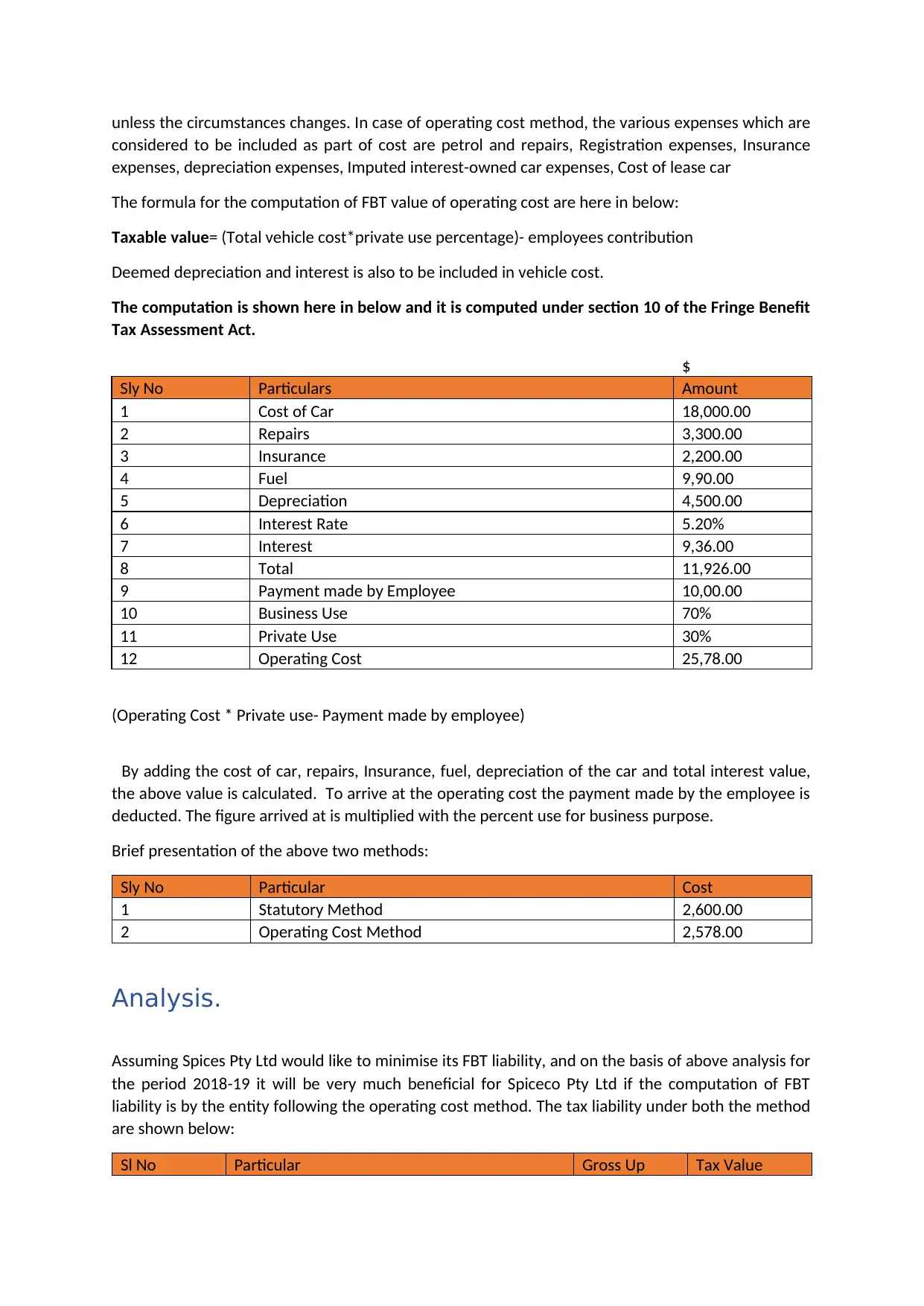
unless the circumstances changes. In case of operating cost method, the various expenses which are
considered to be included as part of cost are petrol and repairs, Registration expenses, Insurance
expenses, depreciation expenses, Imputed interest-owned car expenses, Cost of lease car
The formula for the computation of FBT value of operating cost are here in below:
Taxable value= (Total vehicle cost*private use percentage)- employees contribution
Deemed depreciation and interest is also to be included in vehicle cost.
The computation is shown here in below and it is computed under section 10 of the Fringe Benefit
Tax Assessment Act.
$
Sly No Particulars Amount
1 Cost of Car 18,000.00
2 Repairs 3,300.00
3 Insurance 2,200.00
4 Fuel 9,90.00
5 Depreciation 4,500.00
6 Interest Rate 5.20%
7 Interest 9,36.00
8 Total 11,926.00
9 Payment made by Employee 10,00.00
10 Business Use 70%
11 Private Use 30%
12 Operating Cost 25,78.00
(Operating Cost * Private use- Payment made by employee)
By adding the cost of car, repairs, Insurance, fuel, depreciation of the car and total interest value,
the above value is calculated. To arrive at the operating cost the payment made by the employee is
deducted. The figure arrived at is multiplied with the percent use for business purpose.
Brief presentation of the above two methods:
Sly No Particular Cost
1 Statutory Method 2,600.00
2 Operating Cost Method 2,578.00
Analysis.
Assuming Spices Pty Ltd would like to minimise its FBT liability, and on the basis of above analysis for
the period 2018-19 it will be very much beneficial for Spiceco Pty Ltd if the computation of FBT
liability is by the entity following the operating cost method. The tax liability under both the method
are shown below:
Sl No Particular Gross Up Tax Value
considered to be included as part of cost are petrol and repairs, Registration expenses, Insurance
expenses, depreciation expenses, Imputed interest-owned car expenses, Cost of lease car
The formula for the computation of FBT value of operating cost are here in below:
Taxable value= (Total vehicle cost*private use percentage)- employees contribution
Deemed depreciation and interest is also to be included in vehicle cost.
The computation is shown here in below and it is computed under section 10 of the Fringe Benefit
Tax Assessment Act.
$
Sly No Particulars Amount
1 Cost of Car 18,000.00
2 Repairs 3,300.00
3 Insurance 2,200.00
4 Fuel 9,90.00
5 Depreciation 4,500.00
6 Interest Rate 5.20%
7 Interest 9,36.00
8 Total 11,926.00
9 Payment made by Employee 10,00.00
10 Business Use 70%
11 Private Use 30%
12 Operating Cost 25,78.00
(Operating Cost * Private use- Payment made by employee)
By adding the cost of car, repairs, Insurance, fuel, depreciation of the car and total interest value,
the above value is calculated. To arrive at the operating cost the payment made by the employee is
deducted. The figure arrived at is multiplied with the percent use for business purpose.
Brief presentation of the above two methods:
Sly No Particular Cost
1 Statutory Method 2,600.00
2 Operating Cost Method 2,578.00
Analysis.
Assuming Spices Pty Ltd would like to minimise its FBT liability, and on the basis of above analysis for
the period 2018-19 it will be very much beneficial for Spiceco Pty Ltd if the computation of FBT
liability is by the entity following the operating cost method. The tax liability under both the method
are shown below:
Sl No Particular Gross Up Tax Value
⊘ This is a preview!⊘
Do you want full access?
Subscribe today to unlock all pages.

Trusted by 1+ million students worldwide
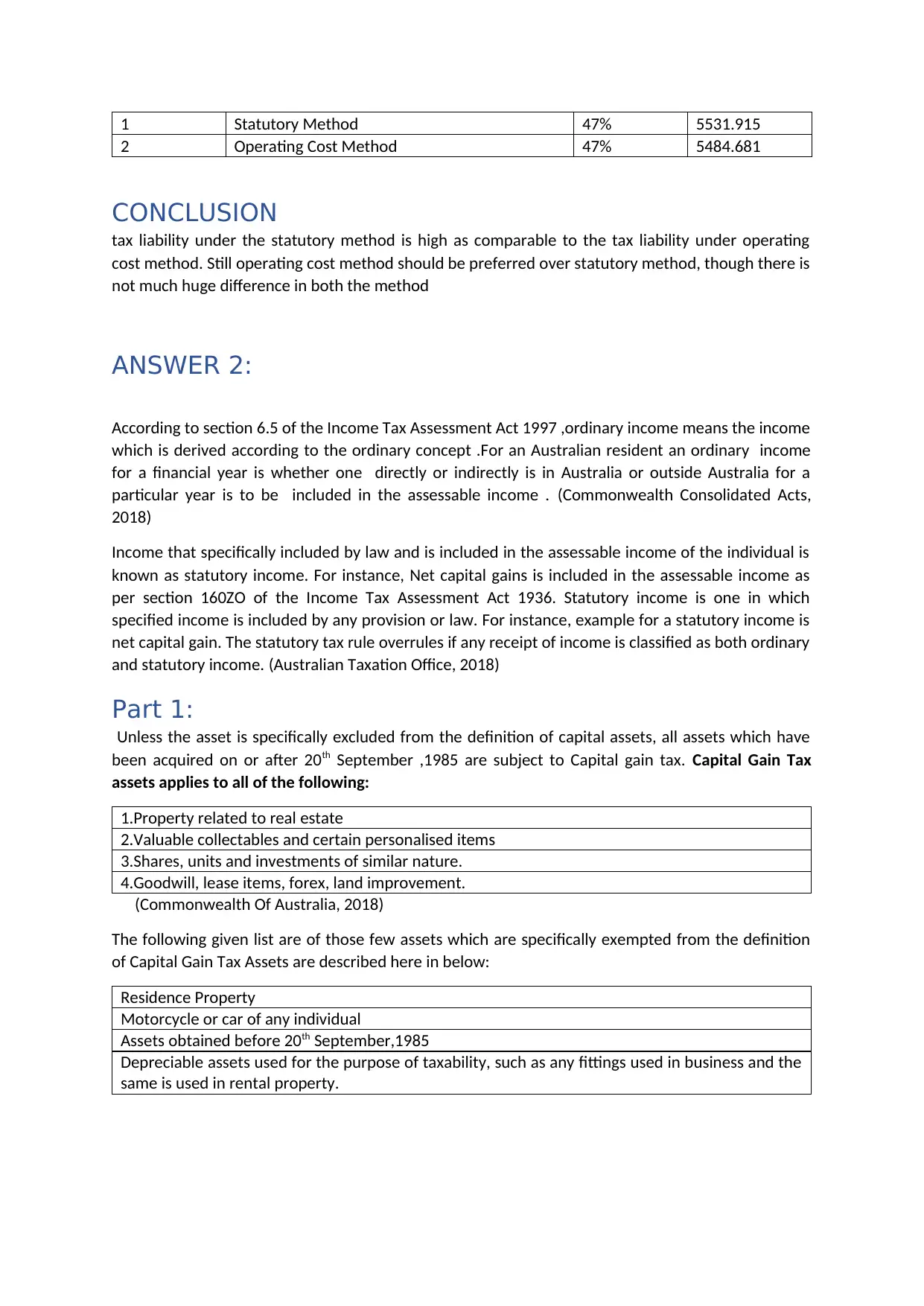
1 Statutory Method 47% 5531.915
2 Operating Cost Method 47% 5484.681
CONCLUSION
tax liability under the statutory method is high as comparable to the tax liability under operating
cost method. Still operating cost method should be preferred over statutory method, though there is
not much huge difference in both the method
ANSWER 2:
According to section 6.5 of the Income Tax Assessment Act 1997 ,ordinary income means the income
which is derived according to the ordinary concept .For an Australian resident an ordinary income
for a financial year is whether one directly or indirectly is in Australia or outside Australia for a
particular year is to be included in the assessable income . (Commonwealth Consolidated Acts,
2018)
Income that specifically included by law and is included in the assessable income of the individual is
known as statutory income. For instance, Net capital gains is included in the assessable income as
per section 160ZO of the Income Tax Assessment Act 1936. Statutory income is one in which
specified income is included by any provision or law. For instance, example for a statutory income is
net capital gain. The statutory tax rule overrules if any receipt of income is classified as both ordinary
and statutory income. (Australian Taxation Office, 2018)
Part 1:
Unless the asset is specifically excluded from the definition of capital assets, all assets which have
been acquired on or after 20th September ,1985 are subject to Capital gain tax. Capital Gain Tax
assets applies to all of the following:
1.Property related to real estate
2.Valuable collectables and certain personalised items
3.Shares, units and investments of similar nature.
4.Goodwill, lease items, forex, land improvement.
(Commonwealth Of Australia, 2018)
The following given list are of those few assets which are specifically exempted from the definition
of Capital Gain Tax Assets are described here in below:
Residence Property
Motorcycle or car of any individual
Assets obtained before 20th September,1985
Depreciable assets used for the purpose of taxability, such as any fittings used in business and the
same is used in rental property.
2 Operating Cost Method 47% 5484.681
CONCLUSION
tax liability under the statutory method is high as comparable to the tax liability under operating
cost method. Still operating cost method should be preferred over statutory method, though there is
not much huge difference in both the method
ANSWER 2:
According to section 6.5 of the Income Tax Assessment Act 1997 ,ordinary income means the income
which is derived according to the ordinary concept .For an Australian resident an ordinary income
for a financial year is whether one directly or indirectly is in Australia or outside Australia for a
particular year is to be included in the assessable income . (Commonwealth Consolidated Acts,
2018)
Income that specifically included by law and is included in the assessable income of the individual is
known as statutory income. For instance, Net capital gains is included in the assessable income as
per section 160ZO of the Income Tax Assessment Act 1936. Statutory income is one in which
specified income is included by any provision or law. For instance, example for a statutory income is
net capital gain. The statutory tax rule overrules if any receipt of income is classified as both ordinary
and statutory income. (Australian Taxation Office, 2018)
Part 1:
Unless the asset is specifically excluded from the definition of capital assets, all assets which have
been acquired on or after 20th September ,1985 are subject to Capital gain tax. Capital Gain Tax
assets applies to all of the following:
1.Property related to real estate
2.Valuable collectables and certain personalised items
3.Shares, units and investments of similar nature.
4.Goodwill, lease items, forex, land improvement.
(Commonwealth Of Australia, 2018)
The following given list are of those few assets which are specifically exempted from the definition
of Capital Gain Tax Assets are described here in below:
Residence Property
Motorcycle or car of any individual
Assets obtained before 20th September,1985
Depreciable assets used for the purpose of taxability, such as any fittings used in business and the
same is used in rental property.
Paraphrase This Document
Need a fresh take? Get an instant paraphrase of this document with our AI Paraphraser
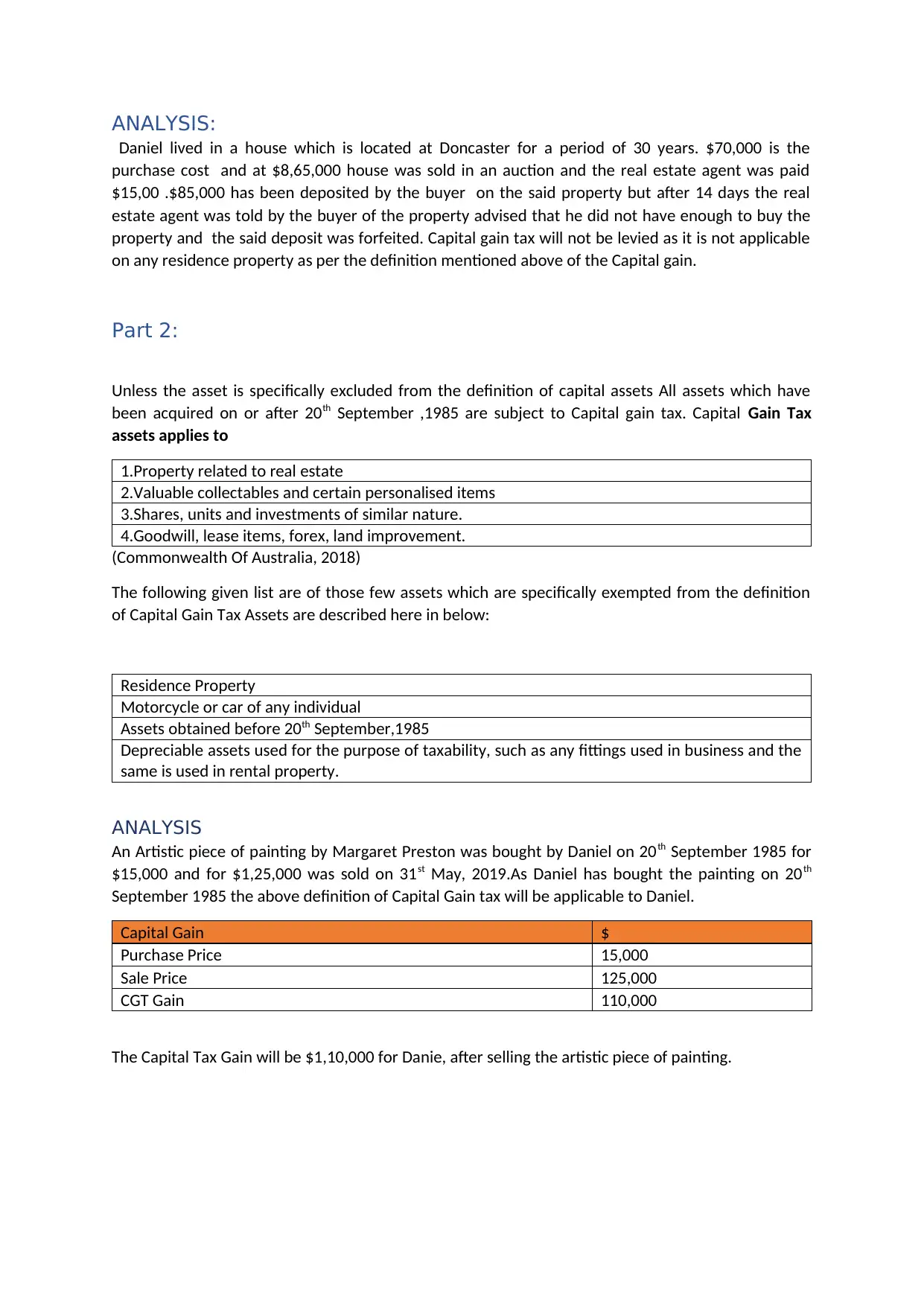
ANALYSIS:
Daniel lived in a house which is located at Doncaster for a period of 30 years. $70,000 is the
purchase cost and at $8,65,000 house was sold in an auction and the real estate agent was paid
$15,00 .$85,000 has been deposited by the buyer on the said property but after 14 days the real
estate agent was told by the buyer of the property advised that he did not have enough to buy the
property and the said deposit was forfeited. Capital gain tax will not be levied as it is not applicable
on any residence property as per the definition mentioned above of the Capital gain.
Part 2:
Unless the asset is specifically excluded from the definition of capital assets All assets which have
been acquired on or after 20th September ,1985 are subject to Capital gain tax. Capital Gain Tax
assets applies to
1.Property related to real estate
2.Valuable collectables and certain personalised items
3.Shares, units and investments of similar nature.
4.Goodwill, lease items, forex, land improvement.
(Commonwealth Of Australia, 2018)
The following given list are of those few assets which are specifically exempted from the definition
of Capital Gain Tax Assets are described here in below:
Residence Property
Motorcycle or car of any individual
Assets obtained before 20th September,1985
Depreciable assets used for the purpose of taxability, such as any fittings used in business and the
same is used in rental property.
ANALYSIS
An Artistic piece of painting by Margaret Preston was bought by Daniel on 20th September 1985 for
$15,000 and for $1,25,000 was sold on 31st May, 2019.As Daniel has bought the painting on 20th
September 1985 the above definition of Capital Gain tax will be applicable to Daniel.
Capital Gain $
Purchase Price 15,000
Sale Price 125,000
CGT Gain 110,000
The Capital Tax Gain will be $1,10,000 for Danie, after selling the artistic piece of painting.
Daniel lived in a house which is located at Doncaster for a period of 30 years. $70,000 is the
purchase cost and at $8,65,000 house was sold in an auction and the real estate agent was paid
$15,00 .$85,000 has been deposited by the buyer on the said property but after 14 days the real
estate agent was told by the buyer of the property advised that he did not have enough to buy the
property and the said deposit was forfeited. Capital gain tax will not be levied as it is not applicable
on any residence property as per the definition mentioned above of the Capital gain.
Part 2:
Unless the asset is specifically excluded from the definition of capital assets All assets which have
been acquired on or after 20th September ,1985 are subject to Capital gain tax. Capital Gain Tax
assets applies to
1.Property related to real estate
2.Valuable collectables and certain personalised items
3.Shares, units and investments of similar nature.
4.Goodwill, lease items, forex, land improvement.
(Commonwealth Of Australia, 2018)
The following given list are of those few assets which are specifically exempted from the definition
of Capital Gain Tax Assets are described here in below:
Residence Property
Motorcycle or car of any individual
Assets obtained before 20th September,1985
Depreciable assets used for the purpose of taxability, such as any fittings used in business and the
same is used in rental property.
ANALYSIS
An Artistic piece of painting by Margaret Preston was bought by Daniel on 20th September 1985 for
$15,000 and for $1,25,000 was sold on 31st May, 2019.As Daniel has bought the painting on 20th
September 1985 the above definition of Capital Gain tax will be applicable to Daniel.
Capital Gain $
Purchase Price 15,000
Sale Price 125,000
CGT Gain 110,000
The Capital Tax Gain will be $1,10,000 for Danie, after selling the artistic piece of painting.
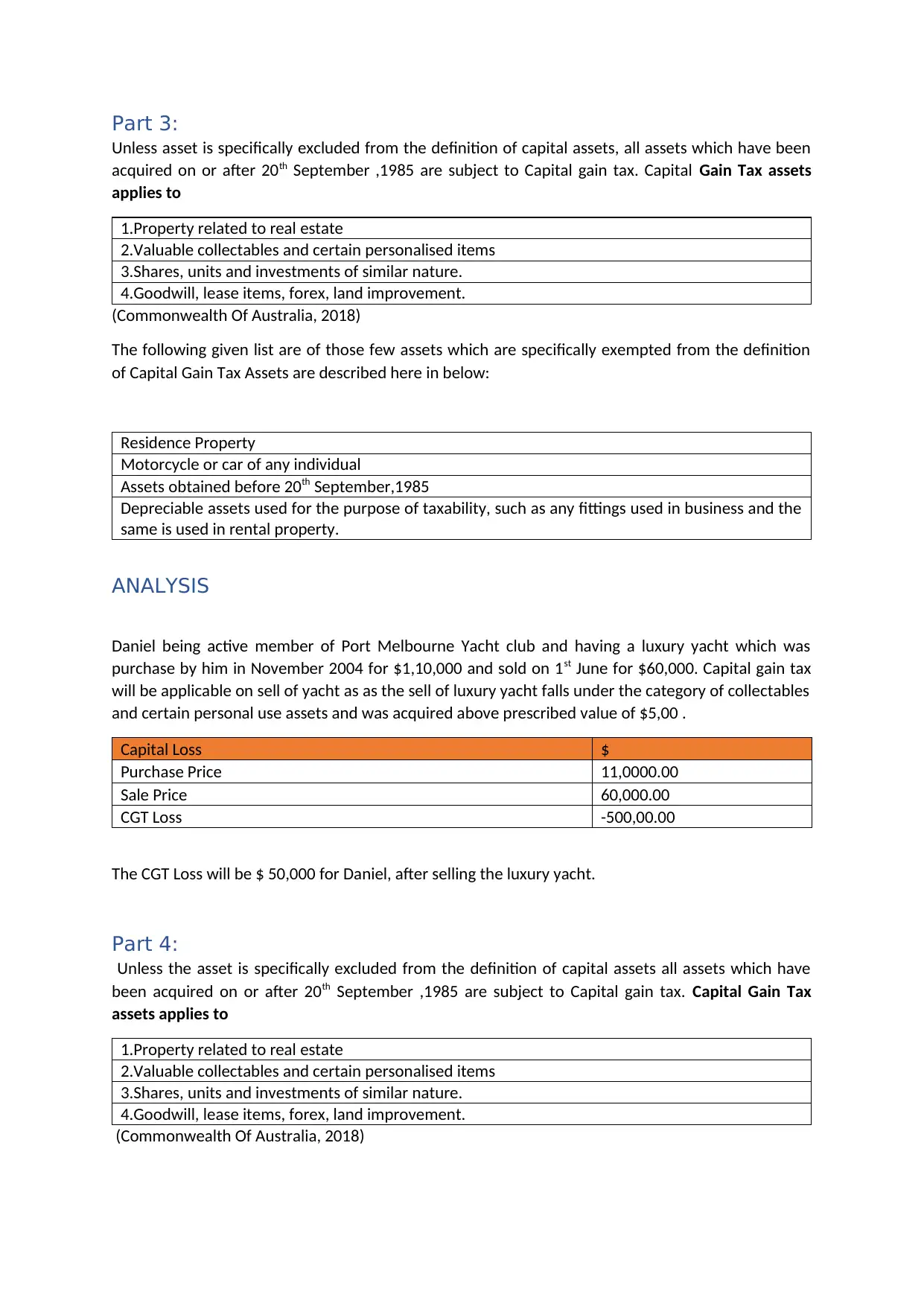
Part 3:
Unless asset is specifically excluded from the definition of capital assets, all assets which have been
acquired on or after 20th September ,1985 are subject to Capital gain tax. Capital Gain Tax assets
applies to
1.Property related to real estate
2.Valuable collectables and certain personalised items
3.Shares, units and investments of similar nature.
4.Goodwill, lease items, forex, land improvement.
(Commonwealth Of Australia, 2018)
The following given list are of those few assets which are specifically exempted from the definition
of Capital Gain Tax Assets are described here in below:
Residence Property
Motorcycle or car of any individual
Assets obtained before 20th September,1985
Depreciable assets used for the purpose of taxability, such as any fittings used in business and the
same is used in rental property.
ANALYSIS
Daniel being active member of Port Melbourne Yacht club and having a luxury yacht which was
purchase by him in November 2004 for $1,10,000 and sold on 1st June for $60,000. Capital gain tax
will be applicable on sell of yacht as as the sell of luxury yacht falls under the category of collectables
and certain personal use assets and was acquired above prescribed value of $5,00 .
Capital Loss $
Purchase Price 11,0000.00
Sale Price 60,000.00
CGT Loss -500,00.00
The CGT Loss will be $ 50,000 for Daniel, after selling the luxury yacht.
Part 4:
Unless the asset is specifically excluded from the definition of capital assets all assets which have
been acquired on or after 20th September ,1985 are subject to Capital gain tax. Capital Gain Tax
assets applies to
1.Property related to real estate
2.Valuable collectables and certain personalised items
3.Shares, units and investments of similar nature.
4.Goodwill, lease items, forex, land improvement.
(Commonwealth Of Australia, 2018)
Unless asset is specifically excluded from the definition of capital assets, all assets which have been
acquired on or after 20th September ,1985 are subject to Capital gain tax. Capital Gain Tax assets
applies to
1.Property related to real estate
2.Valuable collectables and certain personalised items
3.Shares, units and investments of similar nature.
4.Goodwill, lease items, forex, land improvement.
(Commonwealth Of Australia, 2018)
The following given list are of those few assets which are specifically exempted from the definition
of Capital Gain Tax Assets are described here in below:
Residence Property
Motorcycle or car of any individual
Assets obtained before 20th September,1985
Depreciable assets used for the purpose of taxability, such as any fittings used in business and the
same is used in rental property.
ANALYSIS
Daniel being active member of Port Melbourne Yacht club and having a luxury yacht which was
purchase by him in November 2004 for $1,10,000 and sold on 1st June for $60,000. Capital gain tax
will be applicable on sell of yacht as as the sell of luxury yacht falls under the category of collectables
and certain personal use assets and was acquired above prescribed value of $5,00 .
Capital Loss $
Purchase Price 11,0000.00
Sale Price 60,000.00
CGT Loss -500,00.00
The CGT Loss will be $ 50,000 for Daniel, after selling the luxury yacht.
Part 4:
Unless the asset is specifically excluded from the definition of capital assets all assets which have
been acquired on or after 20th September ,1985 are subject to Capital gain tax. Capital Gain Tax
assets applies to
1.Property related to real estate
2.Valuable collectables and certain personalised items
3.Shares, units and investments of similar nature.
4.Goodwill, lease items, forex, land improvement.
(Commonwealth Of Australia, 2018)
⊘ This is a preview!⊘
Do you want full access?
Subscribe today to unlock all pages.

Trusted by 1+ million students worldwide
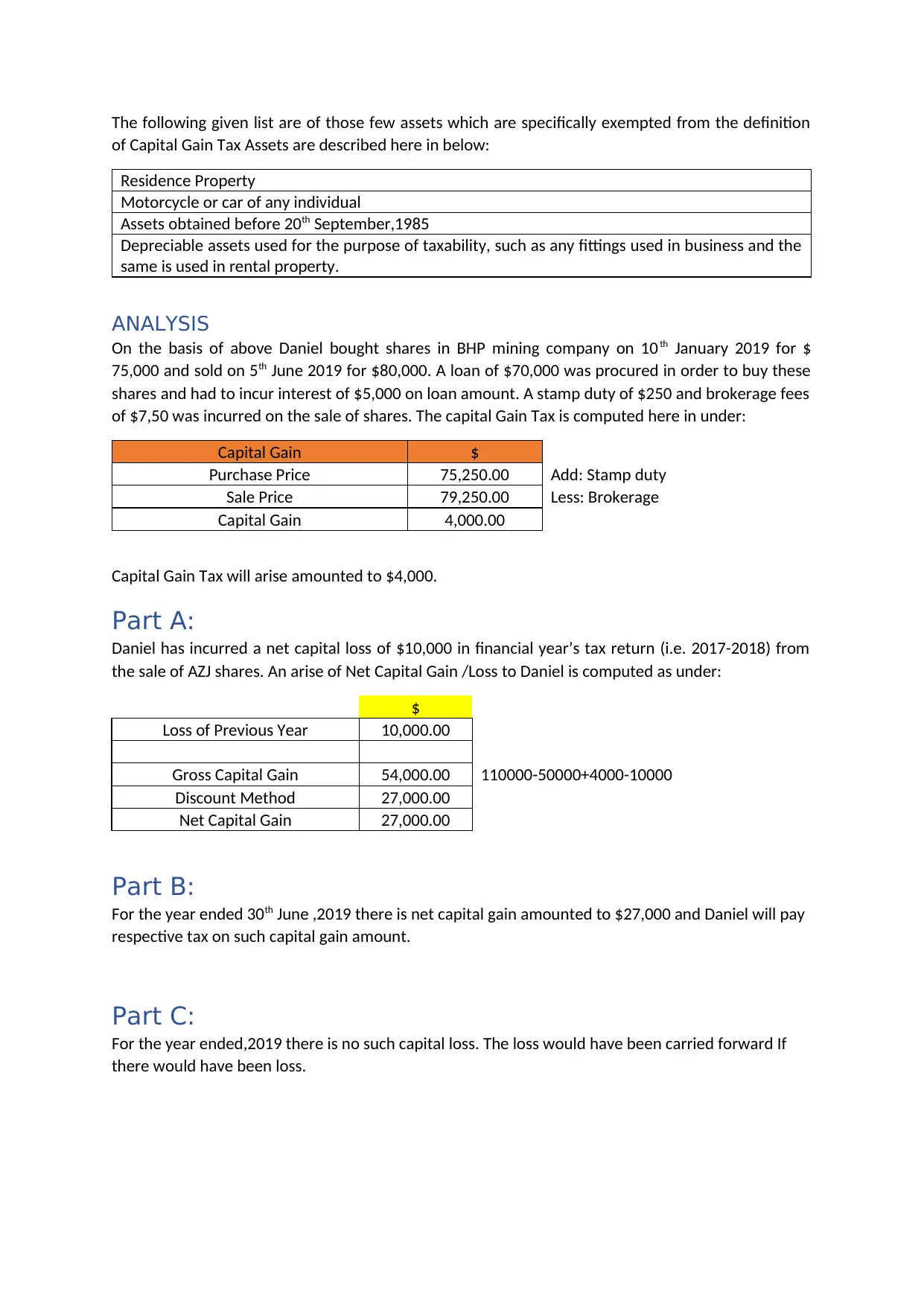
The following given list are of those few assets which are specifically exempted from the definition
of Capital Gain Tax Assets are described here in below:
Residence Property
Motorcycle or car of any individual
Assets obtained before 20th September,1985
Depreciable assets used for the purpose of taxability, such as any fittings used in business and the
same is used in rental property.
ANALYSIS
On the basis of above Daniel bought shares in BHP mining company on 10 th January 2019 for $
75,000 and sold on 5th June 2019 for $80,000. A loan of $70,000 was procured in order to buy these
shares and had to incur interest of $5,000 on loan amount. A stamp duty of $250 and brokerage fees
of $7,50 was incurred on the sale of shares. The capital Gain Tax is computed here in under:
Capital Gain $
Purchase Price 75,250.00 Add: Stamp duty
Sale Price 79,250.00 Less: Brokerage
Capital Gain 4,000.00
Capital Gain Tax will arise amounted to $4,000.
Part A:
Daniel has incurred a net capital loss of $10,000 in financial year’s tax return (i.e. 2017-2018) from
the sale of AZJ shares. An arise of Net Capital Gain /Loss to Daniel is computed as under:
$
Loss of Previous Year 10,000.00
Gross Capital Gain 54,000.00 110000-50000+4000-10000
Discount Method 27,000.00
Net Capital Gain 27,000.00
Part B:
For the year ended 30th June ,2019 there is net capital gain amounted to $27,000 and Daniel will pay
respective tax on such capital gain amount.
Part C:
For the year ended,2019 there is no such capital loss. The loss would have been carried forward If
there would have been loss.
of Capital Gain Tax Assets are described here in below:
Residence Property
Motorcycle or car of any individual
Assets obtained before 20th September,1985
Depreciable assets used for the purpose of taxability, such as any fittings used in business and the
same is used in rental property.
ANALYSIS
On the basis of above Daniel bought shares in BHP mining company on 10 th January 2019 for $
75,000 and sold on 5th June 2019 for $80,000. A loan of $70,000 was procured in order to buy these
shares and had to incur interest of $5,000 on loan amount. A stamp duty of $250 and brokerage fees
of $7,50 was incurred on the sale of shares. The capital Gain Tax is computed here in under:
Capital Gain $
Purchase Price 75,250.00 Add: Stamp duty
Sale Price 79,250.00 Less: Brokerage
Capital Gain 4,000.00
Capital Gain Tax will arise amounted to $4,000.
Part A:
Daniel has incurred a net capital loss of $10,000 in financial year’s tax return (i.e. 2017-2018) from
the sale of AZJ shares. An arise of Net Capital Gain /Loss to Daniel is computed as under:
$
Loss of Previous Year 10,000.00
Gross Capital Gain 54,000.00 110000-50000+4000-10000
Discount Method 27,000.00
Net Capital Gain 27,000.00
Part B:
For the year ended 30th June ,2019 there is net capital gain amounted to $27,000 and Daniel will pay
respective tax on such capital gain amount.
Part C:
For the year ended,2019 there is no such capital loss. The loss would have been carried forward If
there would have been loss.
Paraphrase This Document
Need a fresh take? Get an instant paraphrase of this document with our AI Paraphraser
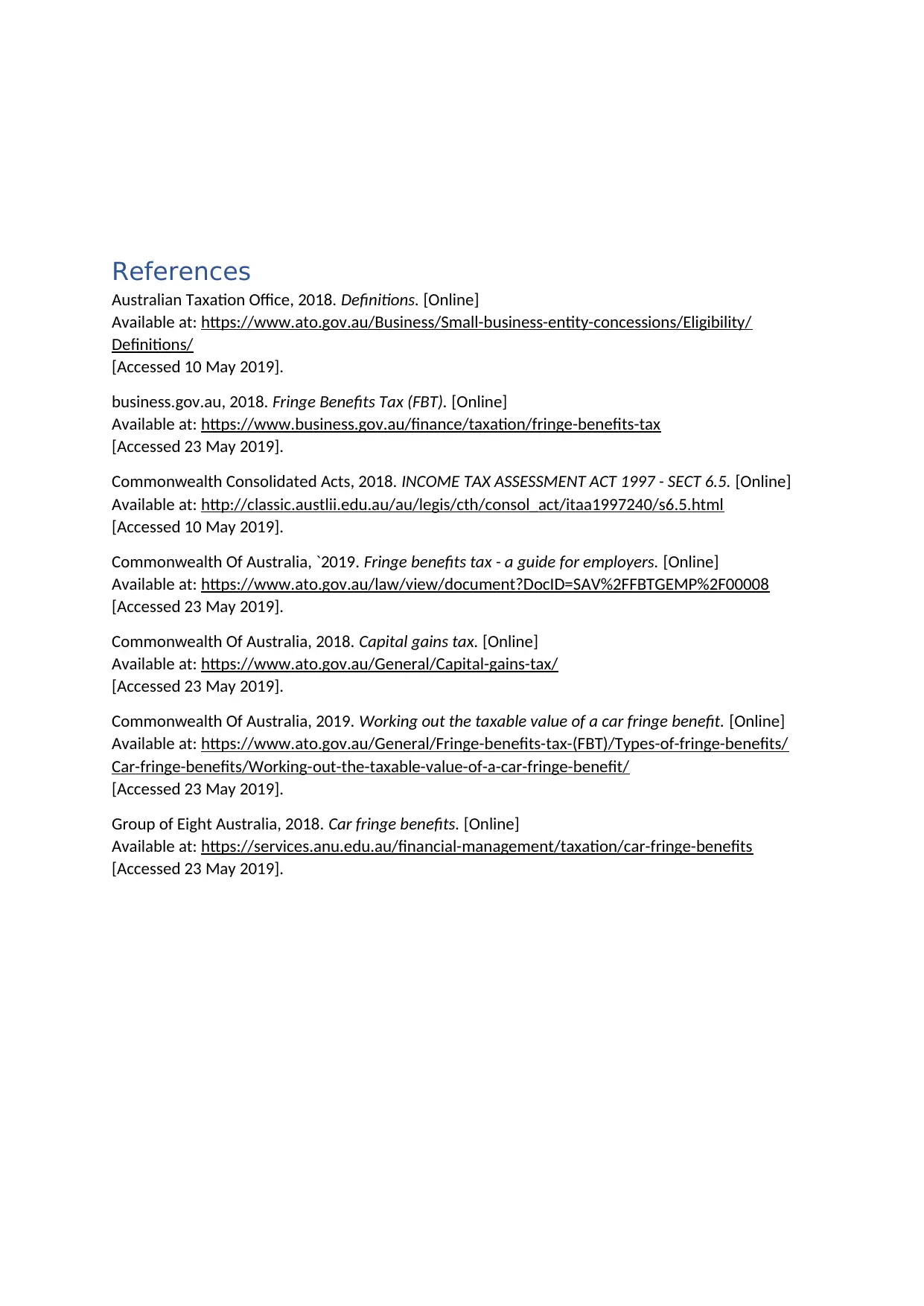
References
Australian Taxation Office, 2018. Definitions. [Online]
Available at: https://www.ato.gov.au/Business/Small-business-entity-concessions/Eligibility/
Definitions/
[Accessed 10 May 2019].
business.gov.au, 2018. Fringe Benefits Tax (FBT). [Online]
Available at: https://www.business.gov.au/finance/taxation/fringe-benefits-tax
[Accessed 23 May 2019].
Commonwealth Consolidated Acts, 2018. INCOME TAX ASSESSMENT ACT 1997 - SECT 6.5. [Online]
Available at: http://classic.austlii.edu.au/au/legis/cth/consol_act/itaa1997240/s6.5.html
[Accessed 10 May 2019].
Commonwealth Of Australia, `2019. Fringe benefits tax - a guide for employers. [Online]
Available at: https://www.ato.gov.au/law/view/document?DocID=SAV%2FFBTGEMP%2F00008
[Accessed 23 May 2019].
Commonwealth Of Australia, 2018. Capital gains tax. [Online]
Available at: https://www.ato.gov.au/General/Capital-gains-tax/
[Accessed 23 May 2019].
Commonwealth Of Australia, 2019. Working out the taxable value of a car fringe benefit. [Online]
Available at: https://www.ato.gov.au/General/Fringe-benefits-tax-(FBT)/Types-of-fringe-benefits/
Car-fringe-benefits/Working-out-the-taxable-value-of-a-car-fringe-benefit/
[Accessed 23 May 2019].
Group of Eight Australia, 2018. Car fringe benefits. [Online]
Available at: https://services.anu.edu.au/financial-management/taxation/car-fringe-benefits
[Accessed 23 May 2019].
Australian Taxation Office, 2018. Definitions. [Online]
Available at: https://www.ato.gov.au/Business/Small-business-entity-concessions/Eligibility/
Definitions/
[Accessed 10 May 2019].
business.gov.au, 2018. Fringe Benefits Tax (FBT). [Online]
Available at: https://www.business.gov.au/finance/taxation/fringe-benefits-tax
[Accessed 23 May 2019].
Commonwealth Consolidated Acts, 2018. INCOME TAX ASSESSMENT ACT 1997 - SECT 6.5. [Online]
Available at: http://classic.austlii.edu.au/au/legis/cth/consol_act/itaa1997240/s6.5.html
[Accessed 10 May 2019].
Commonwealth Of Australia, `2019. Fringe benefits tax - a guide for employers. [Online]
Available at: https://www.ato.gov.au/law/view/document?DocID=SAV%2FFBTGEMP%2F00008
[Accessed 23 May 2019].
Commonwealth Of Australia, 2018. Capital gains tax. [Online]
Available at: https://www.ato.gov.au/General/Capital-gains-tax/
[Accessed 23 May 2019].
Commonwealth Of Australia, 2019. Working out the taxable value of a car fringe benefit. [Online]
Available at: https://www.ato.gov.au/General/Fringe-benefits-tax-(FBT)/Types-of-fringe-benefits/
Car-fringe-benefits/Working-out-the-taxable-value-of-a-car-fringe-benefit/
[Accessed 23 May 2019].
Group of Eight Australia, 2018. Car fringe benefits. [Online]
Available at: https://services.anu.edu.au/financial-management/taxation/car-fringe-benefits
[Accessed 23 May 2019].
1 out of 8
Related Documents
Your All-in-One AI-Powered Toolkit for Academic Success.
+13062052269
info@desklib.com
Available 24*7 on WhatsApp / Email
![[object Object]](/_next/static/media/star-bottom.7253800d.svg)
Unlock your academic potential
© 2024 | Zucol Services PVT LTD | All rights reserved.





